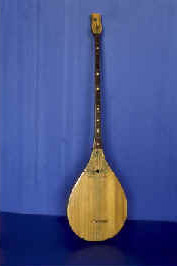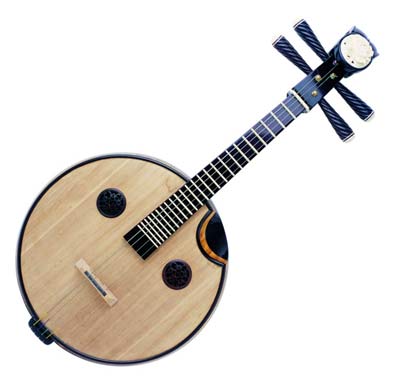 Dongbula
Dongbula
 The dongbula is a stringed musical instrument of the Kazak ethnicity in ancient China. The old and young members of Kazak families are all good at playing the instrument. In Turkic language, the name dongbula has special meanings. Dong describes the sound of the music, and bula means to fix the strings.
The dongbula is a stringed musical instrument of the Kazak ethnicity in ancient China. The old and young members of Kazak families are all good at playing the instrument. In Turkic language, the name dongbula has special meanings. Dong describes the sound of the music, and bula means to fix the strings.
The body of the dongbula is made of wood, and looks like an enlarged spoon. The making of the earliest form of dongbula is very simple. The artist cuts an entire piece of wood into the shape of a spoon, mounts a faceplate, and then draws two pieces of sheep intestines, and finally fits it onto nine tambours at the end of the handle.
With the dongbula, the Kazak people don't feel lonely while out cattle grazing. After returning home, they can enjoy themselves with their families, singing and dancing to the music played by dongbula.
The dongbula can be played solo or in ensemble and accompaniment. The way of performing is quite the same with that of other instruments. Through the various ways of performing the instrument, listeners may have vivid images of gurglingsprings, clear bird twitter, joyful flocks of sheep, and spanking horses with beating hooves.
 Ruan
Ruan
 The ruan is a stringed musical instrument in China. In theQin Dynasty(221-206BC), people altered a wobbling drum into a stringed instrument. Later, with references to the zither and other musical instruments, people created the qin pipa. The qin indicted the Qin Dynasty, and the pipa was a kind of stringed musical instrument. The qin pipa was the predecessor of the ruan.
The ruan is a stringed musical instrument in China. In theQin Dynasty(221-206BC), people altered a wobbling drum into a stringed instrument. Later, with references to the zither and other musical instruments, people created the qin pipa. The qin indicted the Qin Dynasty, and the pipa was a kind of stringed musical instrument. The qin pipa was the predecessor of the ruan.
Around the third century, a musician named Ruan Xian was found to be extremely good at performing the qin pipa. Due to his skillful performances, he was highly welcomed by the local people. Gradually the people named this musical instrument after him. However, it was not called ruan until the Song Dynasty (960-1279).
The ruan is made up of the head, the handle, and the body. The head is usually decorated with some traditional Chinese imagery artwork such as thedragon. There are four tuning gauges on the two sides. The ruan's body is an oblate resonance box. The structural theory, materials, and performing skills are quite similar to those of the pipa.
